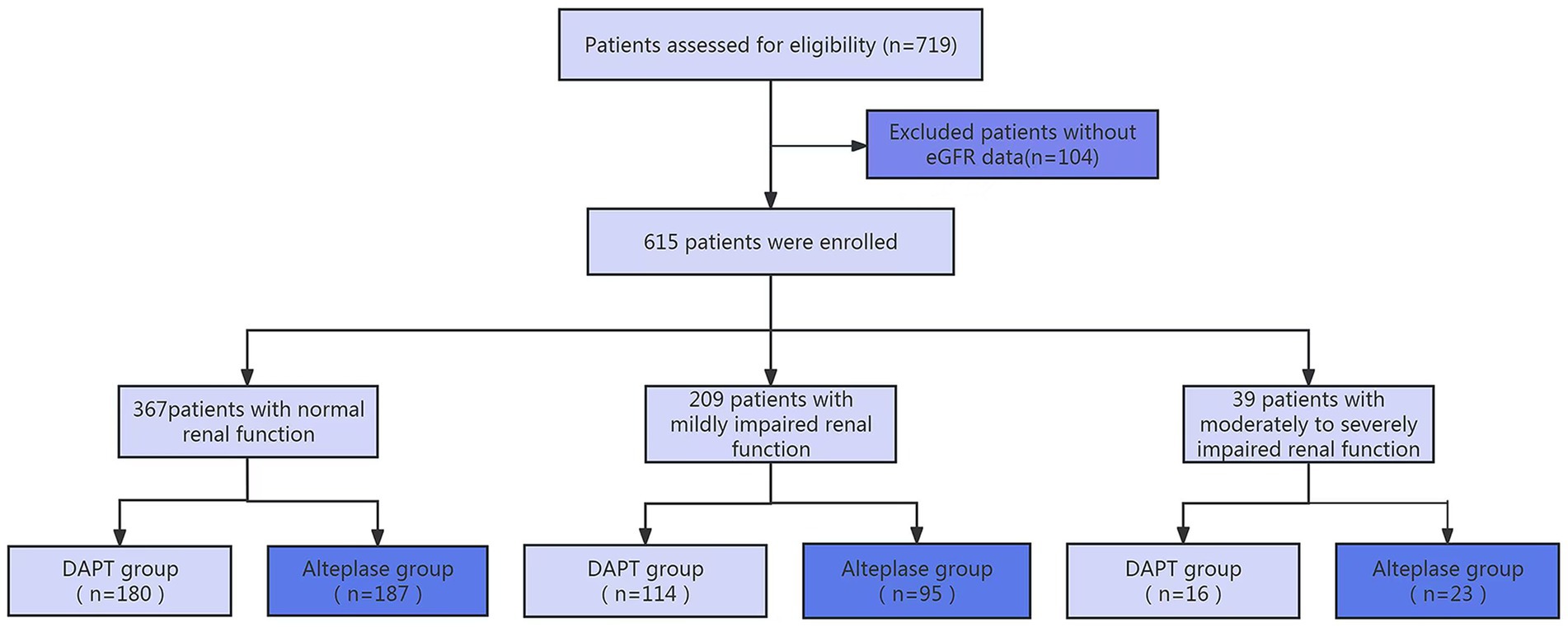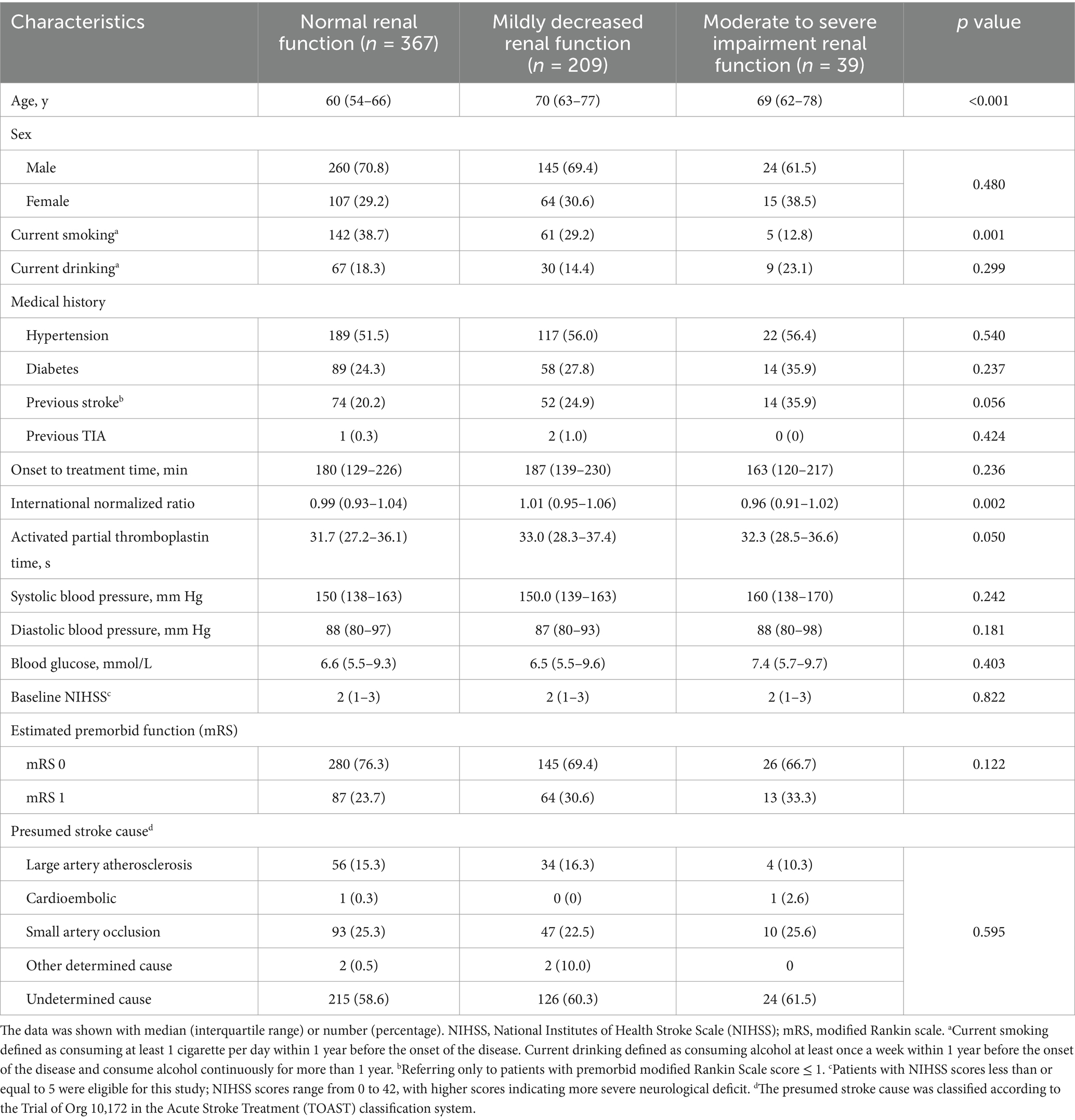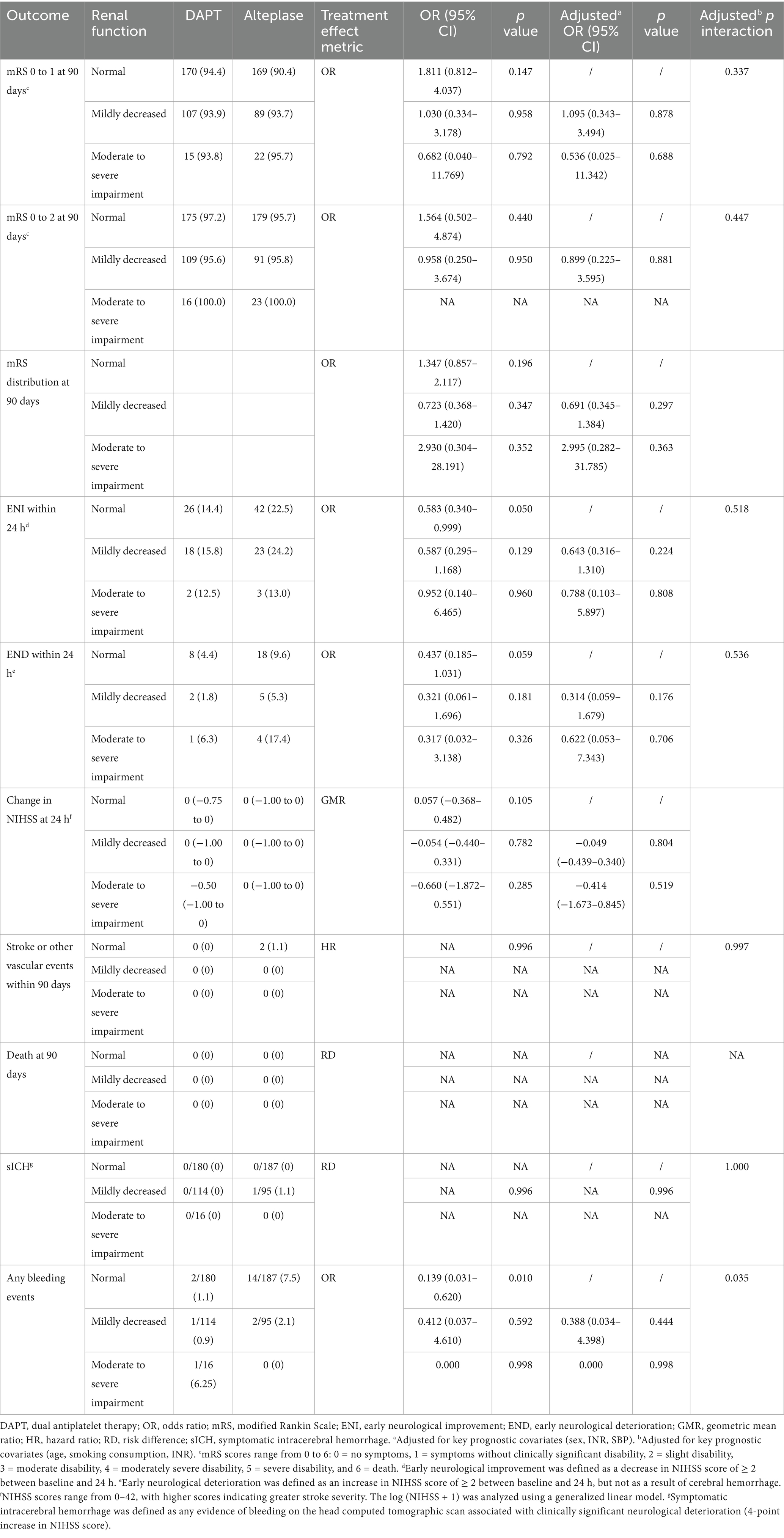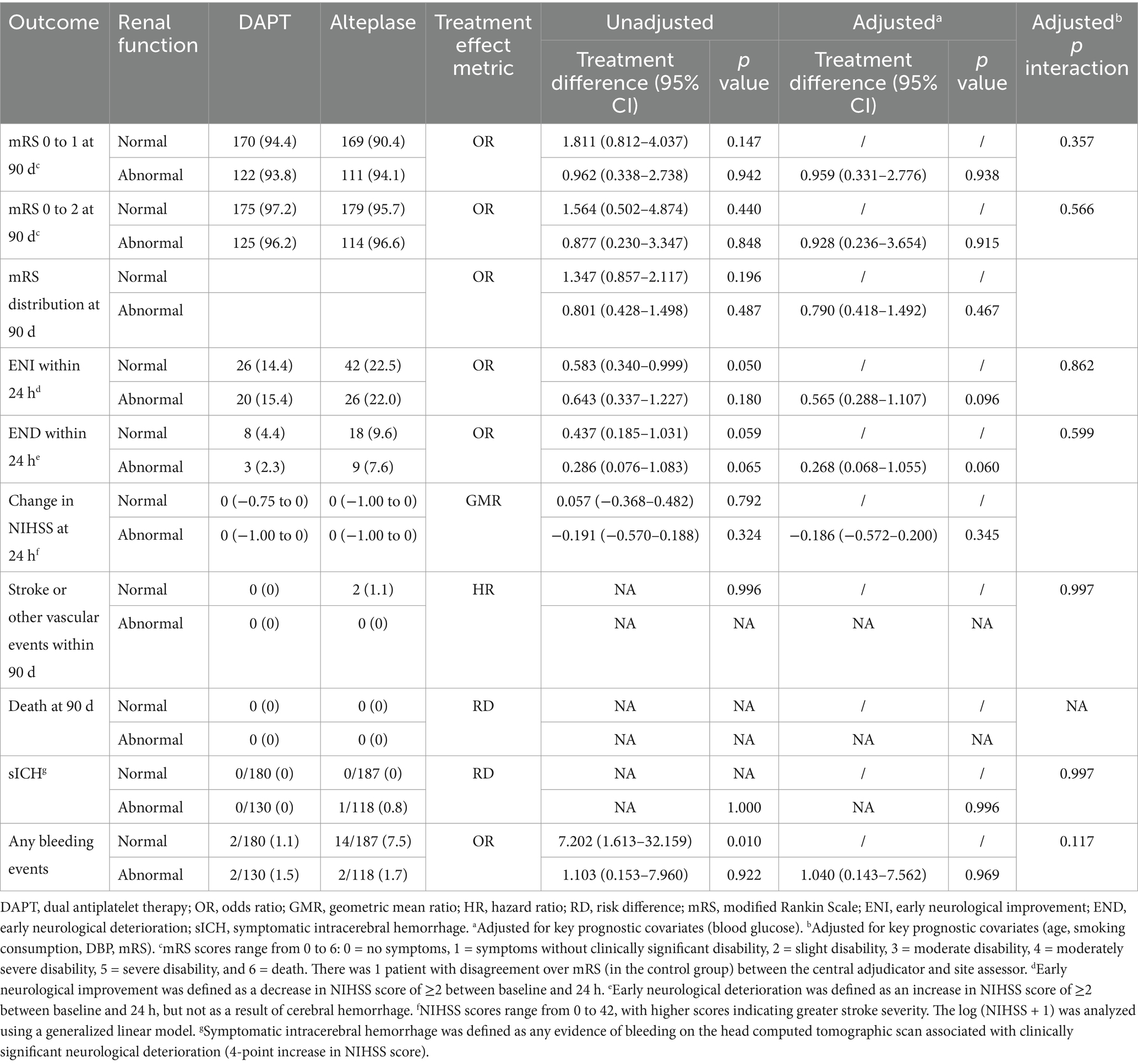- 1Dalian Medical University, Dalian, China
- 2Department of Neurology, General Hospital of Northern Theater Command, Shenyang, China
- 3Department of Neurology, Affiliated Zhongshan Hospital of Dalian University, Dalian, China
Background: This secondary analysis of the ARAMIS trial evaluated renal function’s modifying effects on therapeutic responses to dual antiplatelet therapy (DAPT) versus intravenous thrombolysis in acute minor ischemic stroke.
Methods: Based on the as-treated set, we stratified patients by admission estimated glomerular filtration rate into three groups: normal renal function (≥90 mL/min/1.73 m2), mildly decreased renal function (eGFR 60 to 89 mL/min/1.73 m2), and moderate to severe impairment renal function group (<60 mL/min/1.73 m2). The primary endpoint was excellent functional outcome defined as a modified Rankin Scale score of 0–1 at 90 days.
Results: Among 615 analyzed patients, 367 (59.7%) exhibited normal renal function, 209 (34.0%) exhibited mildly decreased renal function and 39 (6.3%) exhibited moderate to severe impairment renal function. A numerically higher rate of excellent functional outcome was found in normal renal function patients with DAPT vs. alteplase (94.4% vs. 90.4%; p = 0.147), while no intergroup difference emerged in mildly decreased renal function patients (93.9% vs. 93.7%; p = 0.958) and moderate to severe impairment renal function patients (93.8% vs. 95.7%; p = 0.792). There was no significant interaction between treatment and renal function on the primary outcome (adjusted interaction p = 0.337).
Conclusion: Among patients with normal renal function, DAPT was associated with a numerically higher, but not statistically significant, rate of excellent functional outcome in patients with minor nondisabling acute ischemic stroke presenting within 4.5 h of symptom onset compared with alteplase.
Clinical trial registration: ClinicalTrials.gov, identifier NCT03661411.
Introduction
Intravenous thrombolysis constitutes standard care for acute ischemic stroke, its clinical utility in minor nondisabling strokes remains a subject of clinical equipoise (1). Contemporary evidence demonstrates dual antiplatelet therapy’s (DAPT) capacity to mitigate stroke recurrence when initiated within 24 h of symptom onset (2, 3), though its functional outcome benefits remain unestablished. Recently, the ARAMIS (Antiplatelet vs. R-tPA for Acute Mild Ischemic Stroke) trial established noninferiority of DAPT versus alteplase for achieving 90-day functional independence (mRS 0–1) in minor strokes treated within 4.5 h (4).
Chronic kidney disease affects >30% of ischemic stroke patients (5), with emerging data implicating renal insufficiency as an independent predictor of stroke severity, post-stroke disability, and mortality (6–13). Further studies suggest that renal function modulates therapeutic efficacy across stroke interventions—influencing antiplatelet response (14), as well as thrombolysis (15) and thrombectomy outcomes (16). In addition, patients with renal dysfunction have increased platelet activation and aggregation, with a higher prevalence of poor responsiveness to aspirin or clopidogrel antiplatelet treatment (17–19). Despite these associations, the potential modification of DAPT versus thrombolysis treatment effects by renal status in minor stroke remains unexplored.
This investigation leverages ARAMIS trial data to elucidate renal function’s potential role as an effect modifier between DAPT and alteplase in minor nondisabling stroke, evaluating both therapeutic efficacy and safety profiles across renal function strata.
Methods
Study design and participants
The ARAMIS trial methodology has been comprehensively documented in primary publications (4), which was a multicenter randomized design comparing dual antiplatelet therapy (DAPT) against intravenous alteplase in minor stroke (NIHSS ≤ 5 with nondisabling deficits) treated ≤4.5 h post-onset. Inclusion required age ≥ 18 years with preserved consciousness (score = 0) and absence of clinically significant focal deficits (single-item NIHSS ≤ 1). Creatinine availability served as an exclusion criterion. Regulatory approvals were obtained from the General Hospital of Northern Theater Command ethics board and participating centers, with written informed consent from all participants.
Renal stratification
Participants underwent renal function categorization using admission eGFR values: normal renal function group (≥90 mL/min/1.73 m2), mildly decreased renal function group (eGFR 60 to 89 mL/min/1.73 m2), and moderate to severe impairment renal function group (<60 mL/min/1.73 m2) (14, 20, 21). Therapeutic protocols included:
1. Thrombolysis arm: Weight-adjusted alteplase (0.9 mg/kg; 10% bolus + 90% infusion) capped at 90 mg, followed by standard antiplatelet regimens 24 h after alteplase.
2. DAPT arm: Clopidogrel loading (300 mg) on the first day and followed 75 mg/d (12 ± 2d) with aspirin (100 mg/d) followed by guideline-directed maintenance.
3. Neurological status was quantified via NIHSS at baseline and 24 h post-randomization. Follow-up evaluations at 90 days captured functional outcomes (mRS), vascular events, and safety endpoints.
Calculation of eGFR
The eGFR was calculated using the Chronic Kidney Disease Epidemiology Collaboration creatinine equation (CKD-EPI) (22): eGFR = 141 × min(SCr/k,1)α× max(SCr/k,1)–1.209 × 0.993Age × 1.018 (if female). Sex-specific coefficients: k = 0.7 (F)/0.9 (M); α = −0.329 (F)/−0.411 (M). The CKD-EPI China equation was calculated with a coefficient of 1.1 (23).
Study outcomes
The primary outcome was excellent functional outcome at 90 days, defined as a modified Rankin Scale (mRS) score of 0 to 1. The secondary outcomes were favorable functional outcome (mRS score of 0 to 2) at 90 days, change in NIHSS score at 24 h, early neurological improvement at 24 h (defined as a decrease of 2 or more points in the NIHSS score), early neurological deterioration at 24 h (defined as an increase of 2 or more points in the NIHSS score but not as a result of cerebral hemorrhage), new stroke or other vascular events at 90 days, 90-day all-cause mortality, and ordinal shift of the mRS score at 90 days. The safety outcomes were symptomatic intracerebral hemorrhage (sICH), defined as evidence of bleeding on head computed tomographic scan associated with neurological deterioration (≥4-point increase in NIHSS score), and any bleeding event during the study.
Statistical analysis
This exploratory secondary analysis was based on the as-treated set. Non-normal continuous variables expressed as median [IQR] with Mann–Whitney comparisons. Categorical data analyzed via χ2 tests.
For functional outcome at 90 days, change in NIHSS score at 24 h, early neurological improvement at 24 h, early neurological deterioration at 24 h, new stroke or other vascular events at 90 days, 90-day all-cause mortality, ordinal shift of mRS score at 90 days, sICH and any bleeding event, binary logistic regression analyses were performed. The treatment effects for the above outcomes are presented as odds ratios (ORs) with 95% confidence intervals (CIs). Covariate adjusted analyses were also performed for all outcomes, adjusting for the unbalanced baseline characteristics with p < 0.05. The interaction between renal function and treatment effect was also analyzed. As a sensitive analysis, we further compared the treatment effects in another grouping method (eGFR: ≥90 vs. <90 mL/min/1.73m2). SPSS 26.0 software and R software version 4.1.0 (R Foundation for Statistical Computing) were used for statistical analysis, and a bilateral test was used. When p < 0.05 there was statistical significance.
Results
Baseline characteristics
As shown in Figure 1, following exclusion of 104 participants lacking baseline eGFR measurements, the final cohort comprised 615 individuals stratified by renal function status: normal (n = 367, 59.7%) versus mildly decreased (n = 209, 34.0%) and moderate to severe impairment (n = 39, 6.3%) (Figure 1). Table 1 presented patient characteristics among three groups by eGFR category. Baseline demographic disparities emerged between renal subgroups for age, smoking history, and international normalized ratio. Table 2 compared the patient characteristics between DAPT and alteplase groups across the three groups. Treatment arms maintained balance across renal function categories except for sex and international normalized ratio in mildly decreased renal function subgroup, and systolic pressure in moderate to severe impairment renal function subgroup (Table 2).
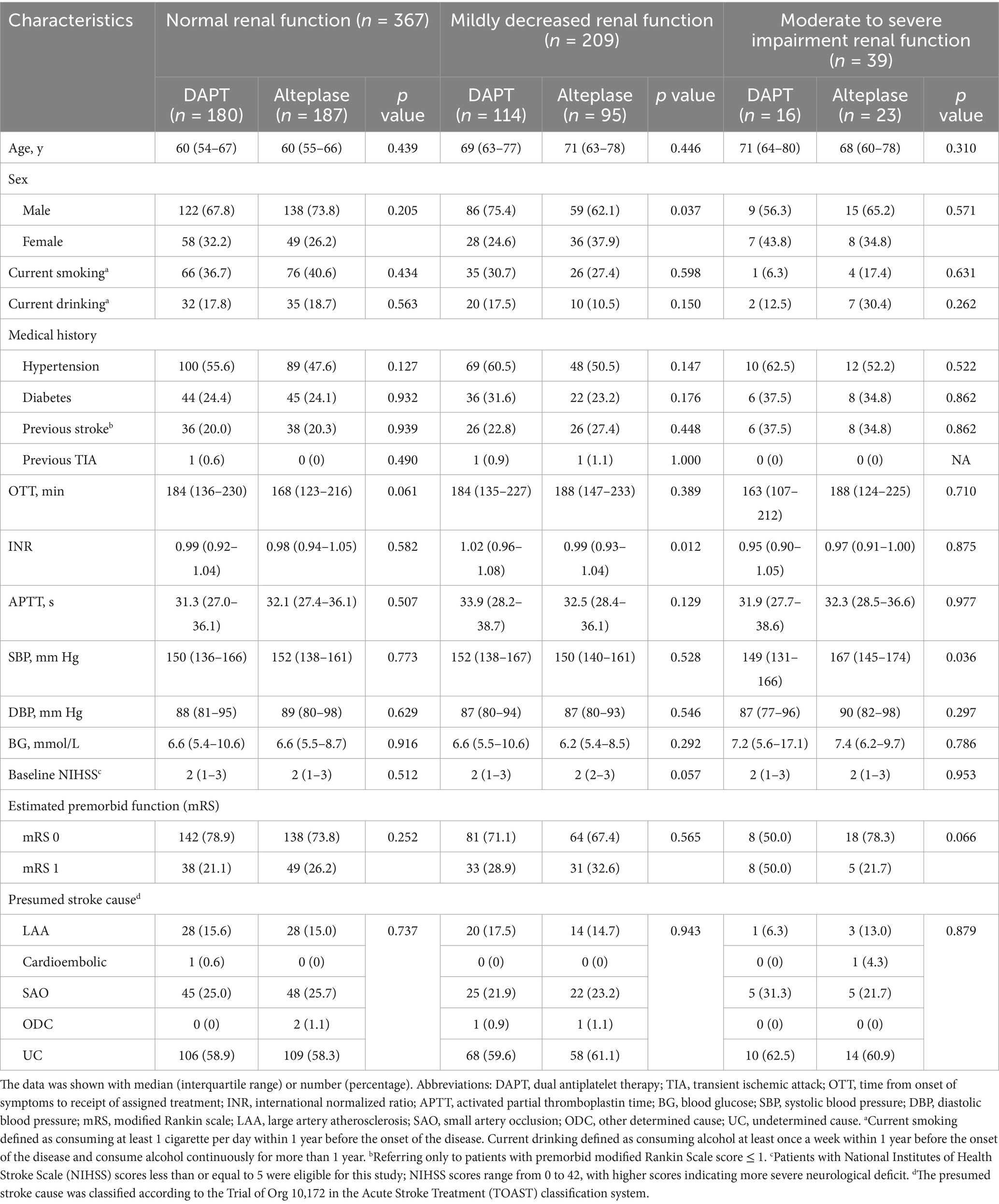
Table 2. Comparison of patient characteristics between DAPT and alteplase groups across the three groups by eGFR category.
Table 3 presented clinical outcomes. Intervention effects stratified by renal function revealed a numerically higher proportion of excellent functional outcome (mRS 0–1) with DAPT versus alteplase in normal renal function (94.4% vs. 90.4%; absolute difference 4.0%, OR = 1.81 [95% CI 0.81–4.04], p = 0.147), contrasting with comparable efficacy in mildly decreased renal function subgroup (93.9% vs. 93.7%; absolute difference: 0.2%; adjusted OR = 1.095 [95% CI 0.343–3.494], p = 0.878) and moderate to severe impairment renal function subgroup (93.8% vs. 95.7%; absolute difference: 1.9%; adjusted OR = 0.536 [95% CI 0.025–11.342], p = 0.688) (Table 3). Formal interaction testing demonstrated nonsignificant renal function-by-treatment effect on primary outcome (adjusted P interaction = 0.337). As shown in Figure 2, parallel patterns emerged for functional recovery (mRS 0–2) and ordinal mRS distribution.
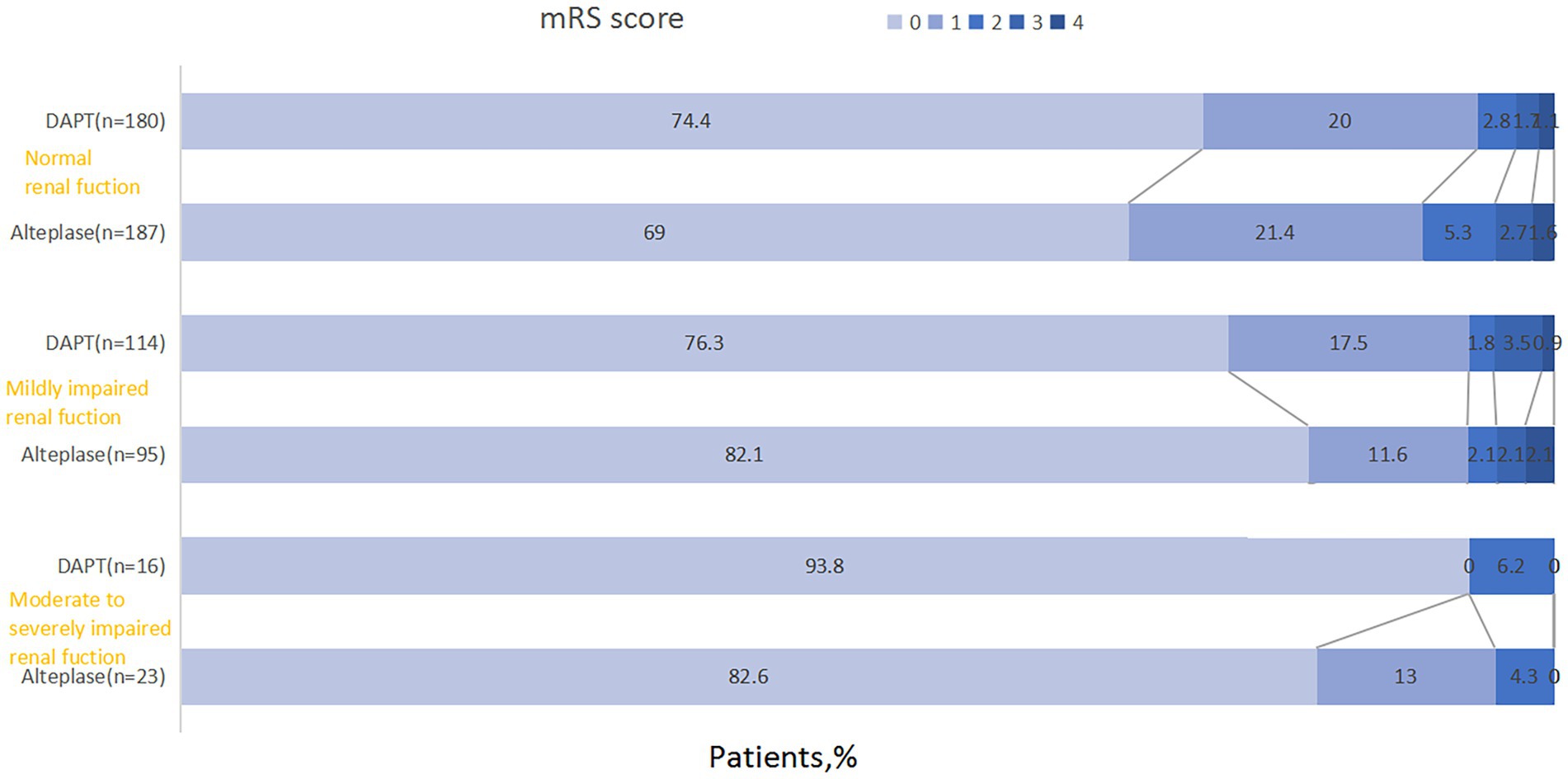
Figure 2. Distribution of modified Rankin Scale (mRS) score between three groups according to renal function status.
Consistent with primary trial findings (4), thrombolysis arm exhibited greater 24-h neurological improvement rates and lower neurological deterioration incidence compared to DAPT, irrespective of renal status (Table 3). Secondary endpoints including 24 h NIHSS change, 90-day vascular events, and mortality showed no intergroup differences (Table 3).
As to the safety outcomes, no sICH occurred in patients with normal renal function and moderate to severe impairment renal function subgroup, while 1 patient experienced sICH in the alteplase group with mildly decreased renal function subgroup (Table 3).
As a sensitive analysis, we analyzed the results in patients stratified by eGFR ≥90 vs. <90 mL/min/1.73m2. The baseline characteristics of this stratification population are shown in Table 4. The similar results were found in this grouping patients (Table 5).
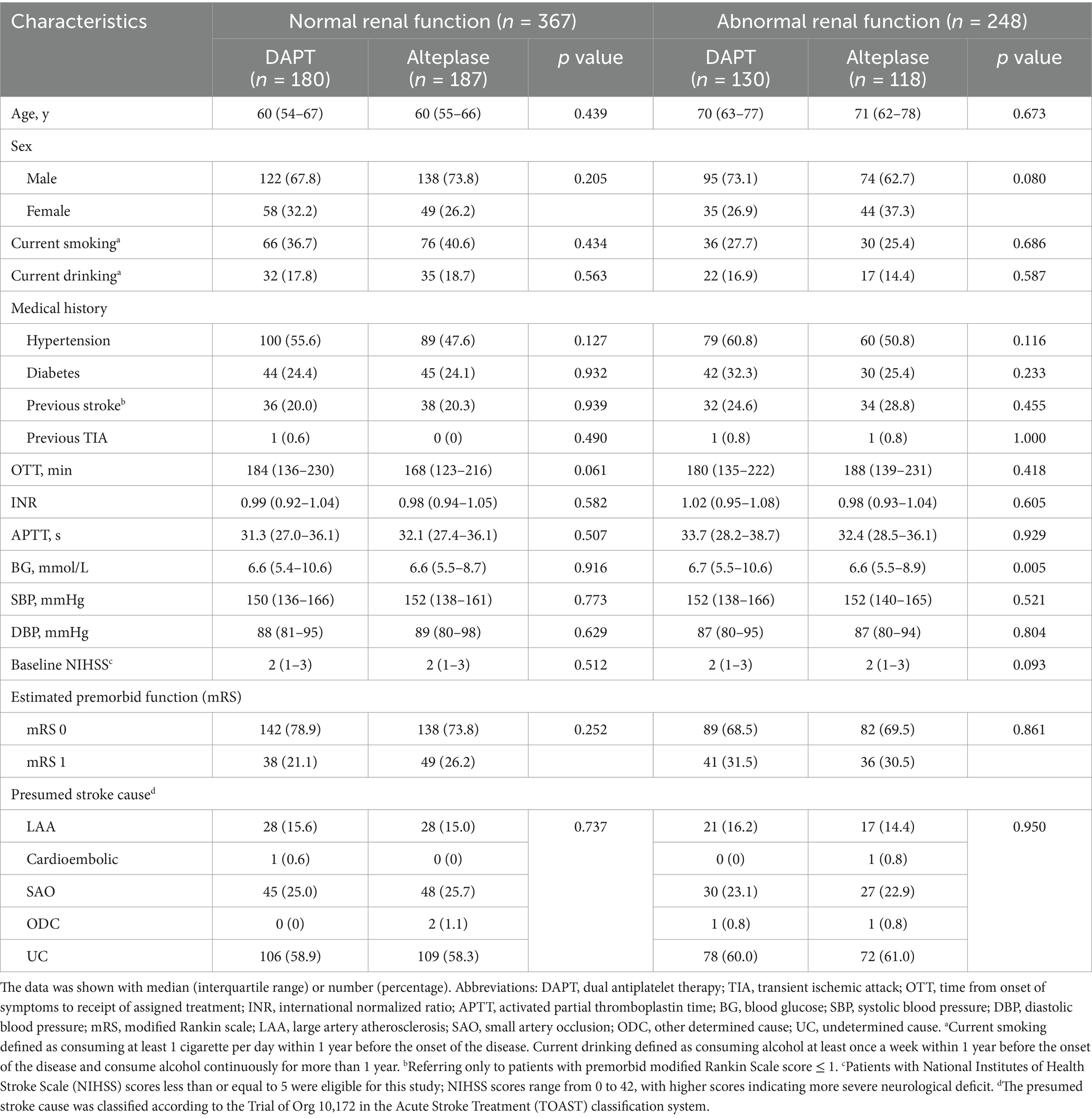
Table 4. Comparison of patient characteristics between the two groups by eGFR ≥90 vs.<90 mL/min/1.73m2.
When eGFR was used as a continuous variable, DAPT was more likely to result in an excellent functional outcome than alteplase in patients with normal renal function (OR = 1.448 [95% CI 0.773–2.713], p = 0.247). As shown in Figure 3, the likelihood of an excellent functional outcome increased as eGFR increased in the DAPT group, but there was a reverse trend in the alteplase group.
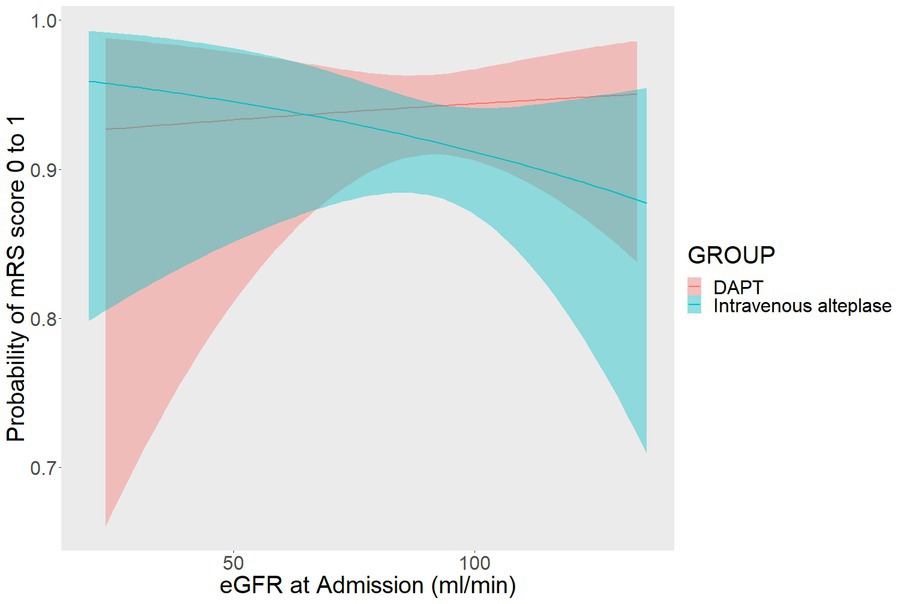
Figure 3. The relationship between the probability of modified Rankin Scale (mRS) score 0 to1 and estimated glomerular filtration rate (eGFR).
Discussion
The ARAMIS trial established non-inferiority of dual antiplatelet therapy (DAPT) versus intravenous alteplase for achieving 90-day functional independence in minor nondisabling strokes treated within 4.5 h. Our exploratory analysis revealed a numerical trend favoring DAPT over thrombolysis in preserved renal function cohorts (adjusted OR = 1.81), though statistical significance remained elusive potentially due to subgroup sample constraints.
In agreement with the previous epidemiological statistics (24), patients with renal impairment were older and had a higher burden of current smoking in this post hoc analysis. These results seem plausible given the obvious influence of age (25), and smoking (26)on renal function, and their close associations with stroke (27).
In this secondary analysis, we found that patients with better renal function are more likely to have an excellent functional outcome in DAPT group, which is consistent with previous findings that renal function was associated with the antiplatelet treatment effect after stroke (14). Nephropathy was associated with altered cerebral perfusion, cerebral neurovascular coupling, and blood vessel integrity (28). Furthermore, the kidney and brain share similar microvasculature and vaso-regulation, which makes them susceptible to microvascular dysfunction (29). These findings indicate that renal function may mirror cerebral autoregulation function (30). Collectively, we argue that impaired renal function may weaken the treatment effect of DAPT through impairing cerebral autoregulation, remodeling the cerebral vasculature, and reducing cerebral blood flow (CBF) (11). Similar to this phenomenon, previous studies have shown that patients with renal impairment did not benefit from intravenous thrombolysis treatment (31). One possible explanation could be that patients with renal insufficiency have reduced fibrinolysis rates, which may be due to less clot permeability and higher clot rigidity (32, 33). In addition, potential mechanisms by which renal impairment affects outcome and complications of intravenous thrombolysis may involve renal anemia, oxidative stress, inflammation, endothelial dysfunction, and paradoxical effects on hemostatic abnormalities, including increased risk of both bleeding and thrombosis (34, 35).
The major strength of this study was the first report to investigate the effect of renal function on the efficacy and safety of DAPT vs. alteplase based on a multicenter, randomized, open-label, blinded end-point assessment, noninferiority study. However, we admitted several limitations. The main limitation was the sample imbalance between two groups, which may weaken the statistical power as well as the validity of the findings. For example, moderate to severe impairment group only has 39 patients (6.3%). Second, only Chinese individuals were enrolled in this study, which may affect the generalizability of this finding given the differences in co-morbid factors and stroke etiology compared with other populations. Third, high rates of the primary outcome due to mild neurological deficit may have created a ceiling effect that limited the opportunity for either agent of DAPT or alteplase to show superiority to the other. These limitations would affect the generalizability of this finding. Finally, this finding should be interpreted with caution due to the nature of the secondary analysis.
In conclusion, among patients with normal renal function, DAPT was associated with a numerically higher, but not statistically significant, rate of excellent functional outcome at 90 days in patients with minor nondisabling acute ischemic stroke presenting within 4.5 h of symptom onset, compared with alteplase.
Data availability statement
The raw data supporting the conclusions of this article will be made available by the authors, without undue reservation.
Ethics statement
The studies involving humans were approved by the Ethics Committee of the General Hospital of Northern Theater Command. The studies were conducted in accordance with the local legislation and institutional requirements. The participants provided their written informed consent to participate in this study.
Author contributions
X-YH: Data curation, Formal analysis, Writing – original draft. CH: Data curation, Formal analysis, Writing – original draft. H-SC: Conceptualization, Supervision, Writing – review & editing.
Funding
The author(s) declare that financial support was received for the research and/or publication of this article. This study was funded by the National Key R&D Program of China (2017YFC1308203) and the Science and Technology Project Plan of Liao Ning Province (2023JH2/101700103).
Acknowledgments
We thank all the participating hospitals and clinician investigators. All authors confirm that the following manuscript is a transparent and honest account of the reported research. This research is related to a previous study by the same authors titled “Sex Differences in the Dual Antiplatelet Therapy Versus Alteplase for Patients with Minor Nondisabling Acute Ischemic Stroke: A Secondary Analysis of the ARAMIS Study.” The previous study was performed on the effect of sex on the treatment effect of alteplase vs. DAPT in minor stroke and the current submission is focusing on the effect of renal function on the treatment effect of alteplase vs. DAPT in the same population. The study is following the methodology explained in Methods section.
Conflict of interest
The authors declare that the research was conducted in the absence of any commercial or financial relationships that could be construed as a potential conflict of interest.
Generative AI statement
The authors declare that no Gen AI was used in the creation of this manuscript.
Publisher’s note
All claims expressed in this article are solely those of the authors and do not necessarily represent those of their affiliated organizations, or those of the publisher, the editors and the reviewers. Any product that may be evaluated in this article, or claim that may be made by its manufacturer, is not guaranteed or endorsed by the publisher.
References
1. Khatri, P, Kleindorfer, DO, Devlin, T, Sawyer, RN Jr, Starr, M, Mejilla, J, et al. Effect of alteplase vs aspirin on functional outcome for patients with acute ischemic stroke and minor nondisabling neurologic deficits: the PRISMS randomized clinical trial. JAMA. (2018) 320:156–66. doi: 10.1001/jama.2018.8496
2. Wang, Y, Wang, Y, Zhao, X, Liu, L, Wang, D, Wang, C, et al. CHANCE investigators. Clopidogrel with aspirin in acute minor stroke or transient ischemic attack. N Engl J Med. (2013) 369:11–9. doi: 10.1056/NEJMoa1215340
3. Johnston, SC, Easton, JD, Farrant, M, Barsan, W, Conwit, RA, Elm, JJ, et al. Clopidogrel and aspirin in acute ischemic stroke and high-risk TIA. N Engl J Med. (2018) 379:215–25. doi: 10.1056/NEJMoa1800410
4. Chen, HS, Cui, Y, Zhou, ZH, Zhang, H, Wang, LX, Wang, WZ, et al. Dual antiplatelet therapy vs Alteplase for patients with minor nondisabling acute ischemic stroke: the ARAMIS randomized clinical trial. JAMA. (2023) 329:2135–44. doi: 10.1001/jama.2023.7827
5. Ovbiagele, B, Schwamm, LH, Smith, EE, Grau-Sepulveda, MV, Saver, JL, Bhatt, DL, et al. Patterns of care quality and prognosis among hospitalized ischemic stroke patients with chronic kidney disease. J Am Heart Assoc. (2014) 3:e000905. doi: 10.1161/JAHA.114.000905
6. Masson, P, Webster, A, Hong, M, Turner, R, Lindley, RI, and Craig, JC. Chronic kidney disease and the risk of stroke: a systematic review and meta-analysis. Nephrol Dial Transplant. (2015) 30:1162–9. doi: 10.1093/ndt/gfv009
7. Ovbiagele, B, Sanossian, N, Liebeskind, DS, Kim, D, Ali, LK, Pineda, S, et al. Indices of kidney dysfunction and discharge outcomes in hospitalized stroke patients without known renal disease. Cerebrovasc Dis. (2009) 28:582–8. doi: 10.1159/000247602
8. Kumai, Y, Kamouchi, M, Hata, J, Ago, T, Kitayama, J, Nakane, H, et al. FSR investigators. Proteinuria and clinical outcomes after ischemic stroke. Neurology. (2012) 78:1909–15. doi: 10.1212/WNL.0b013e318259e110
9. Ei Husseini, N, Fonarow, GC, Smith, EE, Ju, C, Schwamm, LH, Hernandez, AF, et al. Renal dysfunction is associated with Poststroke discharge disposition and in-hospital mortality: findings from get with the guidelines-stroke. Stroke. (2017) 48:327–34. doi: 10.1161/STROKEAHA.116.014601
10. Ei Husseini, N, Fonarow, GC, Smith, EE, Ju, C, Sheng, S, Schwamm, LH, et al. Association of kidney function with 30-day and 1-year poststroke mortality and hospital readmission. Stroke. (2018) 49:2896–903. doi: 10.1161/STROKEAHA.118.022011
11. Alqahtani, F, Berzingi, CO, Aljohani, S, al Hajji, M, Diab, A, Alvi, M, et al. Temporal trends in the outcomes of dialysis patients admitted with acute ischemic stroke. J Am Heart Assoc. (2018) 7:e008686. doi: 10.1161/JAHA.118.008686
12. Synhaeve, NE, van Alebeek, ME, Arntz, RM, Maaijwee, NAM, Rutten-Jacobs, LCA, Schoonderwaldt, HC, et al. Kidney dysfunction increases mortality and incident events after young stroke: the FUTURE study. CerebrovascDis. (2016) 42:224–31. doi: 10.1159/000444683
13. Ovbiagele, B, Pineda, S, and Saver, JL. Renal dysfunction and discharge destination in patients with intracerebral hemorrhage. J Stroke Cerebrovasc Dis. (2011) 20:145–9. doi: 10.1016/j.jstrokecerebrovasdis.2009.11.012
14. Wang, A, Xie, X, Tian, X, Johnston, SC, Li, H, Bath, PM, et al. Ticagrelor-aspirin versus Clopidogrel-aspirin among CYP2C19 loss-of-function carriers with minor stroke or transient ischemic attack in relation to renal function: a post hoc analysis of the CHANCE-2 trial. Ann Intern Med. (2022) 175:1534–42. doi: 10.7326/M22-1667
15. Carr, SJ, Wang, X, Olavarria, VV, Lavados, PM, Rodriguez, JA, Kim, JS, et al. ENCHANTED investigators. Influence of renal impairment on outcome for thrombolysis-treated acute ischemic stroke: ENCHANTED (enhanced control of hypertension and thrombolysis stroke study) post hoc analysis. Stroke. (2017) 48:2605–9. doi: 10.1161/STROKEAHA.117.017808
16. Xiao, L, Ma, M, Gu, M, Han, Y, Wang, H, Zi, W, et al. Renal impairment on clinical outcomes following endovascular recanalization. Neurology. (2020) 94:e464–73. doi: 10.1212/WNL.0000000000008748
17. Capodanno, D, and Angiolillo, DJ. Antithrombotic therapy in patients with chronic kidney disease. Circulation. (2012) 125:2649–61. doi: 10.1161/CIRCULATIONAHA.111.084996
18. Cuisset, T, Frere, C, Moro, PJ, Quilici, J, Pons, C, Gaborit, B, et al. Lack of effect of chronic kidney disease on clopidogrel response with high loading and maintenance doses of clopidogrel after acute coronary syndrome. Thromb Res. (2010) 126:e400–2. doi: 10.1016/j.thromres.2010.08.009
19. Angiolillo, DJ, Bernardo, E, Capodanno, D, Vivas, D, Sabaté, M, Ferreiro, JL, et al. Impact of chronic kidney disease on platelet function profiles in diabetes mellitus patients with coronary artery disease taking dual antiplatelet therapy. J Am Coll Cardiol. (2010) 55:1139–46. doi: 10.1016/j.jacc.2009.10.043
20. Wu, Y, Pan, Y, Wang, M, Meng, X, Wang, Y, Li, S, et al. Influence of impaired renal function on the outcomes of patients with acute ischaemic stroke treated with intravenous tenecteplase and alteplase: a post hoc analysis of the TRACE-2 trial. Stroke Vasc Neurol. (2025) 2025:svn-2024-003726. doi: 10.1136/svn-2024-003726
21. Han, JK, Lee, SD, Hwang, D, Park, SH, Kang, J, Yang, HM, et al. Renal function-stratified comparison of short- and long-term dual antiplatelet therapy in patients undergoing percutaneous coronary intervention with third-generation drug-eluting stents—post hoc analysis from the HOST-IDEA randomized clinical trial. Circ J. (2025) 89:281–91. doi: 10.1253/circj.CJ-24-0481
22. Levey, AS, Stevens, LA, Schmid, CH, Zhang, Y(L), Castro, AF III, Feldman, HI, et al. A new equation to estimate glomerular infiltration rate. Ann Intern Med. (2009) 150:604–12. doi: 10.7326/0003-4819-150-9-200905050-00006
23. Teo, BW, Xu, H, Wang, D, Li, J, Sinha, AK, Shuter, B, et al. GFR estimating equations in a multiethnic Asian population. Am J Kidney Dis. (2011) 58:56–63. doi: 10.1053/j.ajkd.2011.02.393
24. Lv, JC, and Zhang, LX. Prevalence and disease burden of chronic kidney disease. Adv Exp Med Biol. (2019) 1165:3–15. doi: 10.1007/978-981-13-8871-2_1
25. Kitai, Y, Nangaku, M, and Yanagita, M. Aging-related kidney diseases. Contrib Nephrol. (2021) 199:266–73. doi: 10.1159/000517708
26. Formanek, P, Salisbury-Afshar, E, and Afshar, M. Helping patients with ESRD and earlier stages of CKD to quit smoking. Am J Kidney Dis. (2018) 72:255–66. doi: 10.1053/j.ajkd.2018.01.057
27. Dad, T, and Weiner, DE. Stroke and chronic kidney disease: epidemiology, pathogenesis, and management across kidney disease stages. Semin Nephrol. (2015) 35:311–22. doi: 10.1016/j.semnephrol.2015.06.003
28. Sedaghat, S, Vernooij, MW, Loehrer, E, Mattace-Raso, FUS, Hofman, A, van der Lugt, A, et al. Kidney function and cerebral blood flow: the Rotterdam study. J Am Soc Nephrol. (2016) 27:715–21. doi: 10.1681/ASN.2014111118
29. Schiller, A, and Covic, A. Kidney and brain-a renal perspective of ‘les liaisons Dangereuses’. Nephrol Dial Transplant. (2010) 25:1370–3. doi: 10.1093/ndt/gfq068
30. Guo, ZN, Guo, WT, Liu, J, Chang, J, Ma, H, Zhang, P, et al. Changes in cerebral autoregulation and blood biomarkers after remote ischemic preconditioning. Neurology. (2019) 93:e8–e19. doi: 10.1212/WNL.0000000000007732
31. Gensicke, H, Zinkstok, SM, Roos, YB, Seiffge, DJ, Ringleb, P, Artto, V, et al. IV thrombolysis and renal function. Neurology. (2013) 81:1780–8. doi: 10.1212/01.wnl.0000435550.83200.9e
32. Opatrný, K Jr, Zemanová, P, Opatrná, S, and Vít, L. Fibrinolysis in chronic renal failure, dialysis and renal transplantation. Ann Transplant. (2002) 7:34–43.
33. Sjøland, JA, Sidelmann, JJ, Brabrand, M, Pedersen, R, Pedersen, J, Esbensen, K, et al. Fibrin clot structure in patients with end-stage renal disease. Thromb Haemost. (2007) 98:339–45. doi: 10.1160/TH06-12-0715
34. Anavekar, NS, McMurray, JJ, Velazquez, EJ, Solomon, SD, Kober, L, Rouleau, J-L, et al. Relation between renal dysfunction and cardiovascular outcomes after myocardial infarction. N Engl J Med. (2004) 351:1285–95. doi: 10.1056/NEJMoa041365
Keywords: clinical outcome, dual antiplatelet, intravenous thrombolysis, renal function, minor stroke
Citation: He X-Y, He C and Chen H-S (2025) Renal function and efficacy of dual antiplatelet vs. alteplase in minor stroke: a post hoc analysis of ARAMIS study. Front. Neurol. 16:1568711. doi: 10.3389/fneur.2025.1568711
Edited by:
Cheng-Yang Hsieh, Tainan Sin Lau Hospital, TaiwanReviewed by:
Eiichiro Nagata, Tokai University Isehara Hospital, JapanChih-Hao Chen, National Taiwan University Hospital, Taiwan
Copyright © 2025 He, He and Chen. This is an open-access article distributed under the terms of the Creative Commons Attribution License (CC BY). The use, distribution or reproduction in other forums is permitted, provided the original author(s) and the copyright owner(s) are credited and that the original publication in this journal is cited, in accordance with accepted academic practice. No use, distribution or reproduction is permitted which does not comply with these terms.
*Correspondence: Hui-Sheng Chen, Y2hzemhAYWxpeXVuLmNvbQ==
†These authors have contributed equally to this work
 Xiao-Yi He
Xiao-Yi He Chao He
Chao He Hui-Sheng Chen
Hui-Sheng Chen